Tours
Most travelers to the Centennial Exhibition approached the fairgrounds from the east, either by railroad or horse-drawn trolley across the new Girard Avenue Bridge. At the Schuylkill River crossing the first hint of the vast Exhibition grounds was the glass and steel dome of Memorial Hall and the flag-studded towers of the Main Exhibition Building as these came into view above the wooded slope of Fairmount Park. The sheer size of these structures in their natural setting must have been breathtaking.
Visitors were well advised to arrive at the main entrance across from the Pennsylvania Railroad Depot on Elm (now Parkside) Avenue promptly for the 9:00 AM opening. Entrance to the grounds was 50 cents, payable only in paper scrip, which caused endless hardship to those without the proper note. What struck the visitor upon entry was the enormous Bartholdi Fountain midway between Machinery Hall and the Main Exhibition Hall. From this vantage point the first-time visitor had usually one of three objectives: hurry to the center of Machinery Hall to witness the start-up of the Corliss Centennial Steam Engine, board the West-End Narrow Gauge Railway for five cents to view the entire fairgrounds, or cross the square to the right and visit the Department of Public Comfort.
Main Exhibition Hall
The Main Exhibition Hall was the largest structure at the Centennial and the largest building anywhere in the world at the time. The glass and steel frame was over 1880 feet long (officially 1876), and covered more than 20 acres, or six football fields, with well over eleven miles of walkways. The building was functional but also elegant. Walt Whitman approved, "looking up a long while at the grand high roof with its graceful and multitudinous work of iron rods, angles, gray colors, plays of light and shade, receding into dim outlines."
It was in the Main Exhibition Building that 13,720 exhibitors from over 37 countries displayed their manufactures, mostly household goods such as furniture, clothing, tools, clocks, ceramics, glassware, musical instruments, but also scientific and medical apparatus. A 22-year-old George Eastman, visiting from Rochester, wrote to his mother:
I intend to traverse every aisle, I have accomplished this in machinery hall & have got about half through the Main Bldg… The ingenuity that exhibitors have displayed in arranging such things as tacks candles soap hardware needles thread pipe & all such apparently uninteresting articles is something marvelous — and they command the attention of the observer even against his will.
Visitors to the Main Exhibition Building were entertained by concerts held at the central Music Pavilion within the great structure. There were also piano and organ recitals. The Centennial Organ by Hook and Hastings of Boston performed three times daily.
As large as the Main Exhibition Building was, not all of the exhibits fit. A Carriage Exhibit just north of the hall held exhibits of horse-drawn vehicles, and many manufactures exhibited independently in smaller buildings throughout the fairgrounds.
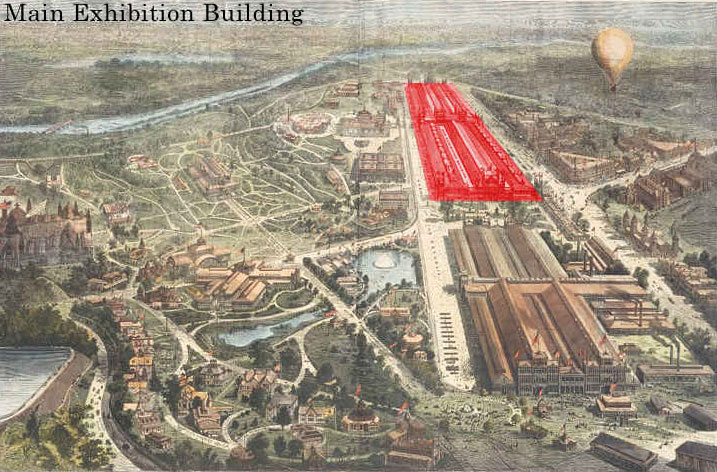
Machinery Hall
To the west of the Main Exhibition Building stood Machinery Hall, if not the largest certainly the most spectacular and the most popular exhibition hall at the Centennial. Occupying over fourteen acres, Machinery Hall served as a showcase for state-of-the-art industrial technology, which in 1876 meant almost entirely steam and hydraulic power, although electricity and the internal combustion engine were both present.
The most memorable display of industrial power at Machinery Hall was the mammoth Corliss Centennial Steam Engine, whose 56-ton flywheel revolved without noise or vibration at 36 RPM. Powered by an external boiler system, the 1,400 horsepower Corliss Engine drove about a mile of shafting throughout Machinery Hall, which supplied free steam power to exhibitors. Visitors who missed the morning start-up could gather again at mid-day after the engine had been allowed to "rest" for another demonstration. Unlike previous exhibitions, the Centennial was closed on Sundays because George H. Corliss would not allow his engine to be operated.
The nearby Hydraulic Annex housed the Cataract, a system of pumps providing a spectacular display of falling water designed to demonstrate the sheer energy of hydraulic power. Its main function was to supply waterpower to nearby hydraulic machinery, but most visitors took advantage of this display to escape the summer heat.
It was in Machinery Hall that most of the industrialized world, and most Americans themselves, first came to realize the potential of American technological development. Popular and innovative exhibits included the Brayton Ready Motor or Hydrocarbon Engine, an early practical internal combustion engine, the Line-Wolf Ammonia Compressor for refrigeration and ice-making, the Otis Brothers & Co. Steam Elevator Machine, the Baldwin Locomotive Works Engine, the Lightning Rotary Cylinder Press, Seth Thomas's Great Clock, the Wallace-Farmer Electromagnetic Generator, and Alexander G. Bell's Telephonic Telegraphic Receiver.
Most foreign visitors were impressed with American techological know-how. Engineer John Anderson noted in the official British Reports on the Centennial:
If we are to be judged by the comparison with Americans in 1876, as doubtless we shall be in the minds of other nations and in their official reports, it is more than probably that the effect will be to confirm… that we are losing our former leadership and it is passing to the Americans.
The Times of London reported that "The American invents as the Greek sculpted and the Italian painted: it is genius." The report of the German Commissioner General, Franz Reuleaux, was unsparing in its praise for the American exhibits and its contempt for Germany's showing:
In arts and crafts Germany has nothing to show but propaganda and patriotic motifs… We have a feeling of shame as we wander through the German section… It seems seven eighths of the space are occupied by Krupp's giant guns, the 'killing machines' which stand like a menace among the peaceful works of the other nations.
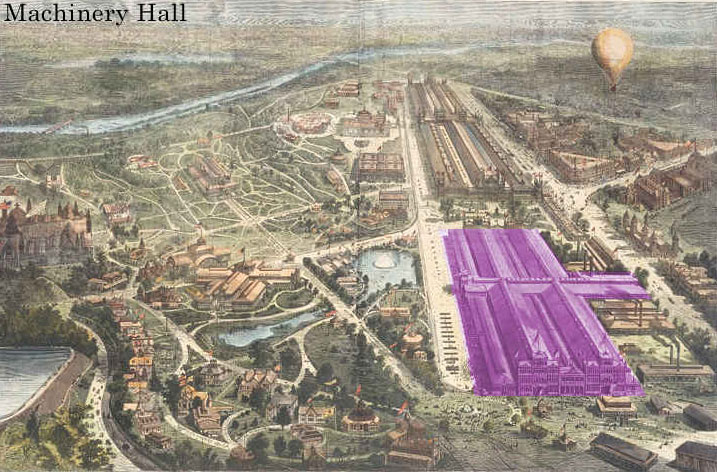
Memorial Hall
Designed as a permanent monument to the Centennial, Memorial Hall was to become the most enduring and influential architectural achievement of Hermann J. Schwarzmann. The massive granite structure, surmounted by a glass and steel dome, was built to a design called Modern Renaissance, and held the Centennial art exhibition. John Sartain, chief of the Centennial Bureau of Art, gathered over 3,256 paintings and drawings, 627 works of sculpture, 431 works of applied art, and nearly 3000 groups of photographs, from 20 nations. So great was the response from exhibitors that a separate Art Annex had to be built, and photographs were displayed in a nearby Photographic Hall.
The paintings exhibited represented for the most part the prosaic art that was so popular at the time, when every picture had to tell a story and, if possible, point a moral. The most popular painting at the Centennial was perhaps The Marriage of H.R.H. the Prince of Wales by W.P. Frith. An official report noted:
the crowd in front of this picture was impassable from the opening to the closing of the doors, and it was necessary to have a guardian continually stationed there to protect the picture, and keep the crowd moving.
The most popular exhibits were the Italian and French sculptures, such as Aurora by J. Bailly. Americans were unaccustomed to artistic license in general, and to nudity in particular, and were variously captivated and appalled by the Europeans. A 34-year-old William James wrote to his brother Henry in Europe:
France has nothing to show… Not that there were any great American works, but there was nothing vile, such as every foreign school gives you in its degenerate pupils… without a grain of inward decency.
No doubt that some of the exhibits were indeed "vile." William Dean Howells remarked on a popular likeness of Cleopatra in Memorial Hall, done in wax and animated:
Attended by a single Cupid, whose ruff, as he moved his head, shows the jointure of his neck; a weary parrot on her finger opens and shuts its wings, and she rolls her head alluringly from side to side and faintly lifts her right arm and lets it drop again — for twelve hours every day. Unlike many sculptures this has no vagueness of sentiment, and it explicitly advertises a museum of anatomy in Philadelphia.
Works exhibited were not avant-garde. The first Impressionist exhibition was held at Paris in 1874, and none of these painters were represented at Philadelphia. Auguste Rodin did exhibit some pieces in the Belgian section. More typical were works such as Nydia, the Blind Flower Girl of Pompeii, by the dean of American sculptors Randolph Rogers, William Wetmore Story's Medea, and Howard Robert's Premiere Pose, now in the Philadelphia Museum of Art. More popular among some visitors were works such as The Dreaming Iolanthe, sculpted by the famed Butter Lady of Arkansas, Caroline S. Brooks, and packed in ice throughout the Centennial.
Memorial Hall became the model for a series of public buildings in Europe: the Reichstag Buildling in Berlin, designed 1882, built 1884-94; Reichsgericht in Leipzig, Czech National Museum in Prague, University Library in Strasbourg, etc.
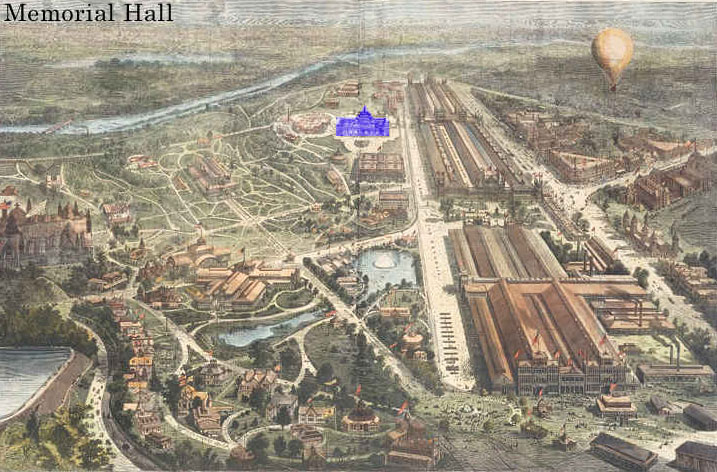
Agricultural Hall
Although the Centennial is remembered today as America's formal entry into the exclusive group of industrialized powers, the United States in 1876 was still an agricultural country. Most Americans lived on farms or in very small towns whose economies reflected the surrounding agricultural life of the nation, and most visitors expected to see the latest in farm machinery and produce. Individual states and exhibitors sent prize-winning farm specimens as if they were attending a county fair. South of the main exhibition grounds was a livestock exhibition area, and the Centennial calendar of events included the Strawberry Display, Trial of Reaping Machines, and the Exhibit of Sheep, Swine, and Goats.
Agricultural Hall, a wooden structure designed in what was termed a Gothic style, covered over nine acres, and was one of the largest buildings at the Centennial. It was host to innumerable displays of produce, agricultural implements, and farm machinery. The only really new devices were the portable steam engines such as the Frick Eclipse. used to power threshing machines, mills, and saws. The steam powered plow was not to become a common sight until late in the 19th Century.
Despite the great size of Agricultural Hall, many exhibits had to be displayed in adjacent structures such as the wagon exhibit, brewery, and the "model butter and cheese factory." In a nearby New England Log House, women in period costume demonstrated cooking and household chores of 1776, one of the few exhibits of America's past. A hastily constructed
Pomological Building
served as an annex for the exhibition of fruit products, and was exceptional for its functional, almost modern design among the Victorian structures.

Horticultural Hall
By most contemporary accounts the most beautiful building of the Centennial, Horticultural Hall was intended to remain after the Exhibition as a permanent botanical conservatory. The structure, designed in what was described as the Moresque style of the 12th Century, was one in a long tradition of glass and steel houses made popular after the Crystal Palace Exhibition at London in 1851. It was the largest building of its kind yet constructed, seeming to float over the surrounding pools and flower beds, a reflection of the Victorian passion for nature.
The interior of the main conservatory, a light-filled expanse of exotic greenery, was centered on a marble fountain designed by American sculptor Margaret Foley, disappointed at the time that her work was not to be exhibited in Memorial Hall. The natural and singular setting afforded her work far more attention than it would have received in the crowded art gallery.
Horticultural Hall was a revelation to most Americans who were not used to seeing such exotic flora, and if some of the specimens exhibited —gladiolus, hyacinths, eucalyptus, ferns, date palms, orange trees, bananas, orchids, cacti— do not seem exotic to us, it should be remembered that many species, such as the chrysanthemum, had been introduced to America barely a generation before.
The conservatory included not only plantings but also extensive displays of seeds, gardening implements, and propagation rooms, and was surrounded by 35 acres of outdoor gardens. In addition, the Centennial was extensively planted in gardens along Fountain Avenue and throughout the grounds.
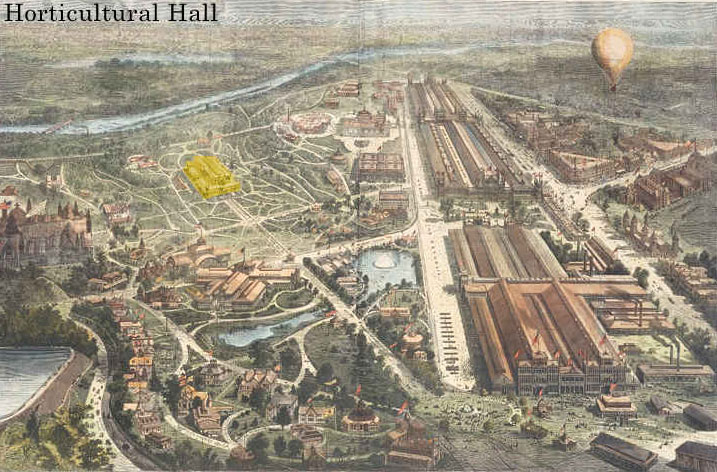
Women's Pavilion
When a group of women was denied permission to exhibit independently in the Main Exhibition Building, the result was one of the novel and more controversial exhibit buildings of the Centennial. The Women’s Pavilion was the brainchild of Mrs. Elizabeth Duane Gillespie and her committee of thirteen Philadelphia ladies. Intended to showcase the abilities of women in all spheres of activity, the Pavilion displayed not only needlework, corsets, and household items, but new inventions such as emergency flares, model interlocking bricks, and a patent land pulverizer. Mrs. Gillespie was adamant in her insistence that every item in the Pavilion be the work of women. Only the structure itself was designed by Schwarzmann, a woman architect from Boston having applied too late for consideration.
A popular attraction was Emma Allison who, dressed in formal attire, tended a steam engine, which in turn powered several other machines in the pavilion, including a printing press, which was used to publish The New Century for Women, the official voice of the Women’s Centennial Committee. To visitors who worried about her safety, Miss Allison replied that tending the steam engine was less tiring and dangerous than working over a kitchen stove.
Mrs. Gillespie was careful not to align herself too closely with what was considered the radical element in the women’s movement at the time. Women’s suffrage was not mentioned, and no attempt was made to identify with the demonstration led by Susan B. Anthony on July 4 at the Independence Hall ceremonies. In a final insult, Women’s Day at the Centennial was celebrated on November 7, Election Day because, it was argued, men would be at the polls and would not mind missing this event.
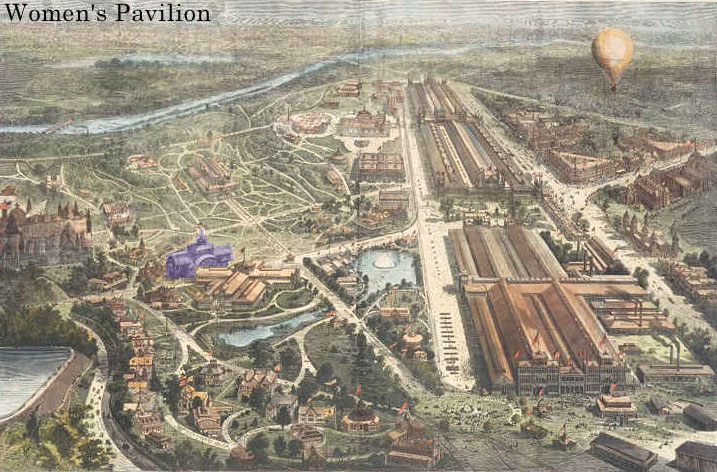
US Gov't Building
The United States Government Building, although often omitted, deserves to be ranked among the largest and most important exhibit buildings of the Centennial. Built in the shape of an immense cross whose arms extended 480 by 340 feet, the building was intended to "illustrate the functions and administrative facilities of the Government in time of peace, and its resources as a war power, and thereby serve to demonstrate the nature of our institutions and their adaptations to the wants of the people." Seven departments were featured: the Agricultural Bureau, the Interior Department, the Smithsonian Institution, the Army, the Navy, the Treasury, and the Post Office.
The Government Building, strange to say, was in many respects the only venue for exhibits of purely scientific and anthropological interest. The Smithsonian mounted an impressive Centennial Indian exhibit, a display of stuffed and mounted wildlife, including plaster and "alcoholic" fishes, and an exhibit of "choice and rare crystalline minerals." The Patent Office showed off some of its more impressive models, while the War and Navy Departments displayed uniforms, artillery, ship models, navigation devices, and astronomical images from the U.S. Naval Observatory.
A small arsenal of weaponry was on display, including Gatling Machine Guns, Hotchkiss Revolving Cannon, and 20 inch Rodman Guns just outside the entrance to the building. Despite this impressive arsenal, Americans were intimidated by the breech-loading Krupp Guns from Germany. War Department representative S.C. Lyford observed:
If this exhibition should be the means of awakening our people to a sense of our national danger and defenseless condition the display of the Government will not have been in vain. It is useless to attempt to conceal from foreigners that against their fleets we have nothing to offer worthy of the name, and it is criminal to allow our own people to remain in ignorance of our condition… we offer ourselves a willing sacrifice to any feeble power that may wish to enforce an unreasonable demand.
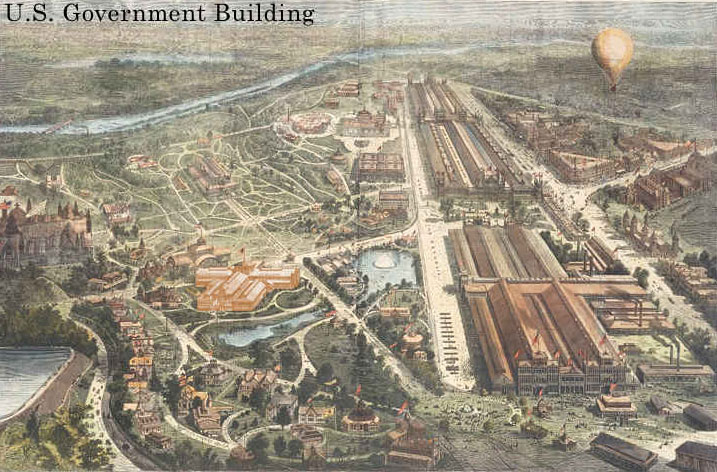
State Buildings
Twenty-four buildings were constructed by various states along State Avenue in the northwest corner of the exhibition grounds and elsewhere. Most of these were not designed as exhibition buildings, but were modest wooden structures that served as headquarters of the individual state Centennial commissioners and as reception rooms where visitors could sign a guest book.
One clear stipulation for state exhibitions was that no reference to the recent Civil War be made that could be construed as political or offensive. Still, most southern states declined to participate. Some were still recovering financially from the War. Mississippi and Arkansas were notable exceptions. Both Virginia and Tennessee were represented by private citizens, Virginia by a guesthouse behind the Women’s Pavilion, and Tennessee by a tent between the Iowa and Maryland buildings. States that mounted exhibits tended to display agricultural produce and other homegrown items. Kansas produced a 20-foot replica of the national capital in corn, topped by a statue of Pomona, the fruit goddess. Iowa displayed 35 giant glass cylinders, each over six feet tall, containing soil samples from its 35 counties
Each state had its designated state day at the Centennial, which included parades along State Avenue, music, and speeches. These days recorded the highest attendance, foremost being Pennsylvania Day, September 28, with 274,919 visitors. Both presidential contenders Samuel J. Tilden of New York and Rutherford B. Hayes of Ohio used their state days to campaign. Delaware-Maryland-Virginia Day featured a jousting match with knights in medieval costume.
Philadelphia newspapers noted with dread the possibility that the state buildings would be donated to the city after the Centennial. Only the Ohio House, constructed of stone quarried in each county, remains to this day on its original site.
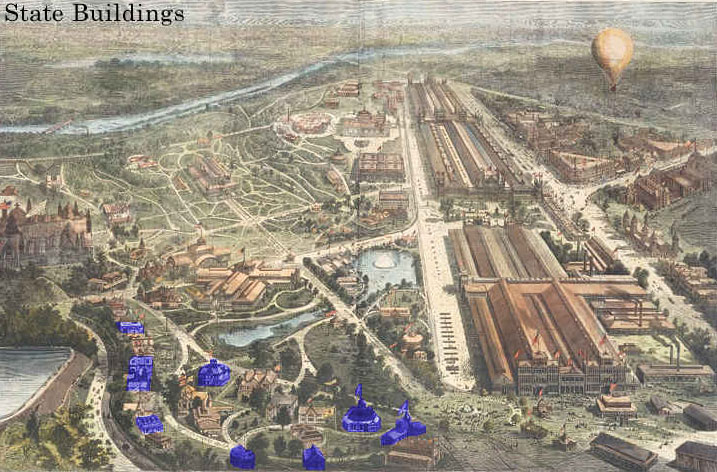
Buildings
The only buildings remaining on site at the Centennial grounds today are Memorial Hall, Ohio House, and two small brick outbuildings just south of the present Horticultural Center. Several buildings have been moved to other locations.
-
The Main Exhibition Building
A group of Philadelphia businessmen headed by Clement M. Biddle determined to keep the Centennial alive by purchasing the Main Exhibition Building and turning it into the Permanent International Exhibition. On December 1, 1876, when most of the Exhibition buildings were auctioned off, the Main Exhibition Building was bought by this group for $250,000. The new Exhibition, which included mostly foreign merchants and manufactures, opened in May 1877 along with the Art Gallery in Memorial Hall. It quickly ran into financial difficulty but continued to remain open through 1879, when the Park Commission complained about the nature of some of the exhibits, which included an animal farm show. The building was finally demolished in 1881. The site now serves as a concourse fronting Memorial Hall. The John W. Welsh Memorial Fountain occupies the site of the interior Music Pavilion.
-
Machinery Hall
We know that the building was still standing in 1879 because it was used as a storage facility for frames of smaller buildings taken down after the close of the Centennial, and at least one was advertised for sale during this year. When it was actually demolished we do not know. Most of these buildings had no central heating or good lighting system, so they were of limited value. Today there is a small lake occupying most of the central area of Machinery Hall. The present Carousel Building beside this site does not date from the Centennial.
-
Memorial Hall
Memorial Hall remains today as the single most significant reminder of the Centennial, as it was intended to be. It became the Pennsylvania Museum and School of Industrial Arts, during which it continued to display some of the art objects of the Centennial. In the 1920's most of these objects were moved to the new Philadelphia Museum of Art, and an auction was held in 1954 to dispose of remaining exhibit material. The building was restored in 1968 as headquarters of the Fairmount Park Commission and the Fairmount Park Guard, including a public recreation center and a social hall for civic functions. The Columbia statue atop the dome, by A.J.M. Muller has undergone several changes, and was completely replaced after a storm, so the present version is not the original. The eagles at the corners of the great structure are missing. No one knows what happened to them. In October 2008, a gloriously restored Memorial Hall reopened as the new home of Philadelphia's Please Touch Museum. A model diorama of the Centennial is still nestled in Memorial Hall's lower level and is the centerpiece of the Museum's "Centennial Exploration" exhibit which features a number of photos drawn from the Free Library's Print and Picture Collection.
-
Horticultural Hall
Horticultural Hall was supposed to remain as a permanent structure; it had central heat and a good lighting system, and remained as a botanical conservatory. Park maps as recent as 1921 show formal gardens planted in front of Horticultural Hall for quite a distance, but aerial photographs from 1928 show mature trees in random patterns all around the building. Horticultural Hall fell into disrepair. Damaged beyond repair in 1954 during Hurricane Hazel, it was finally demolished in 1955. There is now a functional Horticultural Center built in 1973, occupying the site. Just south of the Center are two small brick buildings used as public toilets during the Centennial. They were no doubt built in brick to remain with the "permanent" Horticultural Hall.
-
Agricultural Hall
Agricultural Hall was probably demolished along with the other large buildings. Its lumber was purchased by a developer who sold half of it to Spring Lake, New Jersey beach developers James and Thomas Hunter. The lumber was used for eight homes, a railroad station and a 900-foot-long bridge over Wreck Pond Inlet. Ashling Cottage, at 106 Sussex Avenue in Spring Lake remains as one of the houses constructed from lumber salvaged from Agricultural Hall. Baseball fields now occupy the site of Agricultural Hall.
-
English Building
There were several "English" buildings, but this is probably St. George's House, the large half-timbered structure. It remained for many years as a park maintenance office and residence for park employees. It was finally razed in 1961. There were several smaller buildings in the English area beside St. George's House. Some sources suggest that these remained also until 1961. [Another view]
-
Portuguese Government Building
The Portuguese Government Building, designed by Schwarzmann, was moved to Atlantic Avenue in Spring Lake, New Jersey in 1877. It became a guesthouse and was eventually demolished in 1983.
-
German Government Building
This building, just northwest of the Judge's Pavilion was still present in 1897, but missing in park maps by 1921. We can find no mention of its use after the Centennial.
-
Japanese House
There is a Japanese House today in Fairmount Park near the Horticultural Center. The Shofu-so, or Pine Breeze Villa, was originally a part of a display in the courtyard of the Museum of Modern Art in New York from 1954-55, and moved to Philadelphia shortly after. On the same site as the Shofu-so there used to be a Japanese temple gate. This gate was constructed in the early 16th Century and brought to the United States for the 1904 St. Louis Exposition, where it was purchased by two Philadelphians who moved it to Fairmount Park. It burned in 1955. Neither of these structures have anything to do with the Japanese Dwelling at the Centennial.
-
Swedish School House
The Swedish School House was moved to Central Park in New York. It still stands near the Shakespeare Garden where it serves as an indoor puppet theater.
-
Ohio State Building
Today the only significant structure remaining in its original location besides Memorial Hall is Ohio House, built of stone sent from various Ohio quarries. It became a park employee residence, then a Fairmount Park Information Center. It is now in a state of great disrepair.
-
Rhode Island Building
The Rhode Island Building remained for quite a long time, still present in 1921. We do not know exactly when it was demolished or what it was used for after the Centennial.
-
Maryland State Building
Moved to Druid Hill Park, outside of Baltimore, Maryland. It was used as a sort of natural history museum in the 1930's. In 1978 it was still there; today it is probably one of the buildings on the grounds of the Baltimore Zoo.
-
Wisconsin State Building
Purchased by a private investor, it was moved about half a mile and then left to stand for over a year. Someone else bought it and moved it to Bala where it became the Wisconsin House Hotel. It was finally razed in 1961.
-
Michigan Building
Moved to Atlantic City, New Jersey where it became a private home, then a guesthouse called the States Villa. It burned down in 1961.
-
New Hampshire Building
Purchased by John Goddard in November 1876, and moved to Shore Road in Spring Lake, New Jersey. It was destroyed by fire on April 12, 1962.
-
Missouri State Building
This building was relocated to Ocean Road in Spring Lake, New Jersey in 1877. It is supposed to be the only remaining Centennial building in Spring Lake, although Ashling Cottage, built with lumber from Agricultural Hall also remains.
-
Department of Public Comfort
The main comfort station between the Main Exhibition Hall and Machinery Hall was moved to Spring Lake, New Jersey, where it became the Lake House Hotel, opened in June 1877, with 92 rooms, large dining parlors, and a bowling alley. It was demolished in 1904 and replaced by a public park.
-
Centennial Catalog Building
The Catalog Building to the southeast of Horticultural Hall was moved to Strafford on the Main Line of the Pennsylvania Railroad west of Philadelphia where it became a railroad station, now under historic renovation at a cost of $4.3 million.
-
United States Life Saving Building
This small building behind the Restaurant Trois Frères Provencaux was moved to Cape May Point, New Jersey. Here is where it gets complicated. Several sources say that it became the Episcopal Church St. Peter's By-the-Sea. This church has been moved five times due to beach erosion and now stands at the corner of Ocean Avenue and Lake Drive just inside the beach dunes. However, John Mather, the Senior Warden of St. Peter's says that the Life Saving Building was moved to the old Coast Guard station near the Cape May Light House, and later destroyed in a hurricane; he remembers it. The building that became St. Peters itself, was advertised for sale as a "fine southern yellow pine frame" in 1879. The Episcopal diocese purchased it and modified it by extending one end and adding interior paneling in 1888. The structure uses tongue and groove siding on the exterior and originally had two large sliding doors at each end, suitable for moving large crowds through or large objects in and out; only one remains. The church members are not certain today which building they purchased, but some local historians think it might have been the Froebel Kindergarten. Recent restorations have revealed an original coating of gray paint with red trim.
-
Observation Tower
There were two observation towers at the Centennial. One of them stood outside the grounds to the north. The larger tower had a steam-powered elevator. It was moved to Coney Island, New York, where it stood for many years. At the time it was the tallest structure in the United States.
-
Roads and Railways
Many of the present roads remain or follow the path of Centennial roads. Belmont Avenue is essentially unchanged. Avenue of the Republic is now North Concourse Avenue at whose eastern entrance, near the Centennial police and fire stations now stands the Smith Civil War Memorial, erected after the Centennial. Fountain Avenue is a walkway leading from the new Horticultural Center to the Mann Music Center on George's Hill. Most of State Avenue remains. A Fairmount Park Trolley used to run from a station west of Memorial Hall, following the route of the West End Railway but then extending northward. It was still in operation in the 1940's. [Another view]
Machinery and Large Objects
-
Corliss Centennial Engine
This engine was first dismantled and taken back to Providence, R.I. Then it was purchased by the Pullman Company in Chicago in 1880 for its new car works. Dismantled in 1910 when Pullman switched to electricity, it was stored in pieces for a while, and then sold as scrap at $8 per ton.
-
Babcock & Wilcox Centennial Boiler
Sold to a Brooklyn sugar refinery where it remained in service until 1911, then exhibited at the 1915 Panama Pacific International Exposition at San Francisco. Destroyed sometime after, a 1929 Smithsonian exhibit designed by Babcock & Wilcox used a half-size cutaway model.
-
Krupp Guns
Alfred Krupp tried unsuccessfully to sell his "killing machine" to an American buyer, but it found no market. He then gave it to the Sultan of Turkey, following a practice the Krupp family had followed before in an effort to generate foreign arms orders. Incidentally, the Krupp guns exhibited at the 1867 Paris Exposition were later used to defeat the French during the Franco-Prussian War of 1870.
-
Gramme and Wallace-Farmer Dynamos
The original electrical dynamos from the Centennial were exhibited at the recent 1876 exhibition at the Smithsonian; they are still operational.
-
Other Engines
Almost all other engines were hauled away and used until they fell apart. When the Smithsonian Institution mounted 1876: a Centennial Exhibition in the Arts and Industries Building, similar pieces had to be located and restored.
-
Antietam Model
Two models of the 3,954-ton naval cruiser Antietam were displayed at the United States Government Building. One 42-foot model remained and was used for years to teach midshipmen the art of rigging. It was part of the 1876 exhibition at the Smithsonian Institution. We're not sure where it is today, probably back at Annapolis.
-
Most of the Stuff
A lot of the stuff, if not most of the stuff left over from the United States Government Building and various foreign buildings donated to the United States, was hauled away in 42 freight cars destined for Washington, D.C. This large gift prompted Congress to allocate funds toward a National Museum, which became the Arts and Industries Building of the Smithsonian Institution.
Outdoor Sculpture, etc.
-
Statue of Independence
Bartholdi's Electric Light, or Freedom Enlightening the World, was moved to Madison Square in New York City, where it served to shame the people of New York into providing funds for a pedestal for the Statue of Liberty, which was finally erected in Upper New York Bay in 1886. Fifty terra cotta models of the sculpture were made during the Centennial; three remain, one of them in the collection of Drexel University.
-
Fountain of Water and Light
Bartholdi's Fountain of Water and Light, which greeted visitors at the main entrance, was moved to Washington, D.C. where it now stands across from the Botanic Garden at the southwest corner of Independence Avenue and 1st Street SW. [Another view]
-
Margaret Foley's Fountain
The fountain that stood at the center of Horticultural Hall was stored away in pieces for a while. Some sources say it was lost, but today it stands in a corner of one of the greenhouses at the Fairmount Park Horticultural Center. [Another view]
-
Children's Fountain
Some guidebooks to Baltimore mention a Children's Fountain from the Centennial in the Remington neighborhood of the city between McMechan and Wilson Streets. We don't know where this was at the Centennial. It may not have been known as a Children's Fountain.
-
American Soldier
The American Soldier or Volunteer, the colossal sculpture outside Machinery Hall, now stands at Antietem battlefield in Maryland. [Another view]
-
Columbus Statue
The statue of Christopher Columbus, erected by Italian-American citizens of Philadelphia, stood near the United States Government Buildings. It is now in Marconi Plaza, near the Sports Complex in South Philadelphia. The sculptor may have been Emanuele Caroni. [Another view]
-
Humboldt Statue
The statue of Alexander von Humboldt by Frederick Drake, erected by German-American citizens now stands along West River Drive along the Schuylkill River south of the Belmont Pumping Station, near a more famous statue of Saint George and the Dragon which is not from the Centennial.
-
Catholic Total Abstinence Fountain
Still there where it always was. This ensemble by Herman Kirn (or Kern) is the largest from the Centennial, comprising a 16-ton Moses surrounded by four Catholic patriots. It stands before the Mann Music Center, which occupies the crest of George's Hill, site of a restaurant during the Centennial.
-
Dying Lioness
This sculpture by Wilhelm Wolff was purchased by the Fairmount Park Art Association and now stands just outside the entrance to the Philadelphia Zoo.
-
Pegasus Sculptures
These sculptures by Vincenz Pilz were originally created for the Vienna Opera House but were considered too large. They are still standing just outside Memorial Hall.
-
Richard Allen
Supposed to have been dedicated on November 3 by African American citizens of Philadelphia, the statue is noted on contemporary maps as being in front of the English Buildings. Some accounts say the sculpture was damaged in a train wreck as it was being transported from Ohio to Philadelphia. Then a granite obelisk was constructed in its place, and a portion of the damaged bust was mounted on the obelisk. No one knows what happened to the monument after that. We are still researching this one.
-
William Penn
Many guidebooks mention the dedication of a statue of William Penn, which would eventually be placed atop the new municipal buildings in Philadelphia. It never happened. Although there were plans for its construction, it was not completed until 1894.
-
Witherspoon Monument
This statue of the Presbyterian clergyman by Joseph A. Bailly originally stood a little northeast of Memorial Hall. It now stands just east of the new Horticultural Center, which replaced Horticultural Hall. Bailly also sculpted the Aurora exhibited in Memorial Hall.
-
B'nai B'rith Monument to Religious Liberty
This monument by Moses Ezekiel was originally placed between Memorial Hall and the Annex. Moved several times within Fairmount Park, it is now at the National Museum of American Jewish History, 55 North 5th Street.
-
Washington Statue
This statue stood in front of Judge's Hall. Contemporary guidebooks say it was the property of Mr. Mahlon Dickerson, an American banker in Florence, and was loaned by him to the Centennial.
-
Howe Monument
Maps locate a Howe Monument between Machinery Hall and the lake. Only one source identifies this as Elias Howe, the inventor of an early prototype sewing machine. Howe sued Isaac M. Singer and Company for patent infringement in the longest court case in U.S. history, and was awarded $15,000 and royalties of $25 for every Singer machine, an average of $4000 per week until 1867. He then went into competition with Singer and was awarded a gold medal for a new model at the 1867 Paris Exhibition. The Singer Manufacturing Company Building stood not far from the monument, probably within view. We do not know what happened to the Howe Monument.
-
The Navy
This sculpture by Larkin G. Mead stood at the west corner of Memorial Hall. It was later moved to Springfield, Illinois where it became part of a Lincoln memorial.
-
Portland Brownstone Portal
This was a gift from Portland, Oregon. The Philadelphia Public Art Inventory lists the sculpture as Brownstone Gate to a Footpath, attributed to Frank Furness. It was unclaimed after the Centennial and so became the property of the Fairmount Park Commission. It now stands along Kelly Drive below Laurel Hill.
-
Spanish Cannon
Two Spanish cannon, the Militiades and the Semiramis, cast in 1743, along with a Spanish mortar, still stand at the entrance to Memorial Hall.
Indoor Sculpture, etc.
These are far too numerous to mention or trace, although unlike the machinery, they can probably be found. Many sculptures went to the Pennsylvania Academy of Fine Arts and were considered at the time to be the best ensemble collection in America. By mid-20th Century they were mostly dispersed or sold. Many pieces were purchased by Anthony J. Drexel, including Bartholdi's Young Vintner, and are now part of a collection at Drexel University.
-
Columbus Water Cooler
Sent to the new Capitol building in Hartford, Connecticut.
-
Hiawatha Vase
Purchased by Mrs. Grant for the White House, Washington.
-
America
Large sculpture in the rotunda of Memorial Hall by Bell. It was sent to Washington, later to Chicago. Some sources suggest that it was destroyed.
-
Other objects can probably be traced: the Centennial Vase, Roosevelt Organ, Centennial Organ, Centennial Chimes, Seth Thomas' Great Clock, etc.

















































































































































